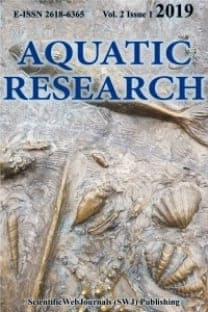Vultivation of Arthrospira platensis in heterotrophic and mixotrophic conditions with different concentrations of whey
___
Bentahar, J., Doyen, A., Beaulieu, L., Deschênes, J.S. (2019). Investigation of β-galactosidase production by microalga Tetradesmus obliquus in determined growth conditions. Journal of Applied Phycology, 31(1), 301-308. https://doi.org/10.1007/s10811-018-1550-yBožanić, R., Barukčić, I., Lisak, K. (2014). Possibilities of whey utilization. Austin Journal of Nutrition and Food Sciences, 2(7), 7.
Bradford, M.M. (1976). A rapid and sensitive method for the quantitation of microgram quantities of protein utilizing the principle of protein-dye binding. Analytical Biochemistry, 72(1-2), 248-254. https://doi.org/10.1016/0003-2697(76)90527-3
Chandra, R., Rohit, M. V., Swamy, Y. V., Mohan, S. V. (2014). Regulatory function of organic carbon supplementation on biodiesel production during growth and nutrient stress phases of mixotrophic microalgae cultivation. Bioresource Technology, 165, 279-287. https://doi.org/10.1016/j.biortech.2014.02.102
Dubois, M., Gilles, K.A., Hamilton, J.K., Rebers, P.A., Smith, F. (1956). Colorimetric method for determination of sugars and related substances. Analytical Chemistry, 28(3), 350-356. https://doi.org/10.1021/ac60111a017 Esen, M., Ozturk Urek, R. (2015). Ammonium nitrate and iron nutrition effects on some nitrogen assimilation enzymes and metabolites in Spirulina platensis. Biotechnology and Applied Biochemistry, 62(2), 275-286. https://doi.org/10.1002/bab.1268
Ghobrini, D., Potocar, T., Smolova, J., Krausova, G., Yakoub-Bougdal, S. et al. (2020). Heterotrophic cultivation of Chlorella vulgaris using saline waste water from the demineralization of cheese whey. Biotechnology Letters, 42(2), 209-217. https://doi.org/10.1007/s10529-019-02770-7
Joannesa, C., Mansaa, R.F., Yasirb, S.M., Dayouc, J. (2016). Comparative studies of cell growth of freshwater microalga Chlorella sp. in photoautotrophic, heterotrophic and mixotrophic cultures. Jurnal Teknologi, 78(7), 83-89. https://doi.org/10.11113/jt.v78.4349
Lichtenthaler, H.K., Wellburn, A.R. (1983). Determinations of total carotenoids and chlorophylls a and b of leaf extracts in different solvents. Biochemical Society Transactions, 11, 591-592. https://doi.org/10.1042/bst0110591
Lutzu, G.A., Zhang, W., Liu, T. (2016). Feasibility of using brewery wastewater for biodiesel production and nutrient removal by Scenedesmus dimorphus. Environmental Technology, 37(12), 1568-1581. https://doi.org/10.1080/09593330.2015.1121292
Maroneze, M.M., Zepka, L.Q., Lopes, E.J., Pérez-Gálvez, A., Roca, M. (2019). Chlorophyll oxidative metabolism during the phototrophic and heterotrophic growth of Scenedesmus obliquus. Antioxidants, 8(12), 600. https://doi.org/10.3390/antiox8120600
Meireles dos Santos, A., Vieira, K.R., Basso Sartori, R., Meireles dos Santos, A., Queiroz, M.I. et al. (2017). Heterotrophic cultivation of cyanobacteria: study of effect of exogenous sources of organic carbon, absolute amount of nutrients, and stirring speed on biomass and lipid productivity. Frontiers in Bioengineering and Biotechnology, 5(12), 1-7. https://doi.org/10.3389/fbioe.2017.00012
Mishra, S.K., Suh, W.I., Farooq, W., Moon, M., Shrivastav, A. et al. (2014). Rapid quantification of microalgal lipids in aqueous medium by a simple colorimetric method. Bioresource Technology, 155, 330-333. https://doi.org/10.1016/j.biortech.2013.12.077 Ozturk Urek, R., Kerimoglu, Y. (2019). Evaluation of effects of Mg2+ and Cu2+ on pigment-metabolite production and photosystem II activity of Arthrospira platensis Gomont 1892. Turkish Journal of Fisheries and Aquatic Sciences, 19(10), 873-883. http://doi.org/10.4194/1303-2712-v19_10_07 Pereira, M.I., Chagas, B.M., Sassi, R., Medeiros, G.F., Aguiar, E.M., Borba, L.H., Rangel, A.H. (2019). Mixotrophic cultivation of Spirulina platensis in dairy wastewater: Effects on the production of biomass, biochemical composition and antioxidant capacity. PloS One, 14(10), e0224294. https://doi.org/10.1371/journal.pone.0224294 Rosas, V.T., Poersch, L.H., Romano, L.A., Tesser, M.B. (2018). Feasibility of the use of Spirulina in aquaculture diets. Reviews Aquaculture, 1-12. https://doi.org/10.1111/raq.12297
Sivakumar, N., Sundararaman, M., Selvakumar, G. (2018). Evaluation of growth performance of Penaeus monodon (Fabricius) fed diet with partial replacement of fishmeal by Spirulina platensis (Sp) meal. Indian Journal of Animal Research, 52(12), 1721-1726. https://doi.org/10.18805/ijar.B-3438
Smithers, G.W. (2008). Whey and whey proteins—from ‘gutter-to-gold’. International Dairy Journal, 18(7), 695-704. https://doi.org/10.1016/j.idairyj.2008.03.008
Velioğlu Tosuner, Z., Öztürk Ürek, R. (2020). Evaluation of sucrose as carbon source in mixotrophic culture of Arthrospira platensis Gomont 1892. Aquatic Research, 3(1), 1-12. https://doi.org/10.3153/AR20001 Velioglu Tosuner, Z., Ozturk Urek, R. (2021). The effects of nutrition on lipid production of Haematococcus pluvialis and biodiesel potential. Environmental Engineering and Management Journal, 20 (8), 1289-1299. https://doi.org/10.30638/eemj.2021.119 Wang, H., Zhou, W., Shao, H., Liu, T. (2017). A comparative analysis of biomass and lipid content in five Tribonema sp. strains at autotrophic, heterotrophic and mixotrophic cultivation. Algal Research, 24, 284-289. https://doi.org/10.1016/j.algal.2017.04.020 Zarrouk, C. (1966). Contribution à l’étude d’une cyanophycée. Influence de divers facteurs physiques et chimiques sur la croissance et la photosynthèse de Spirulina maxima. PhD, Université de Paris, Paris, France.
Zhan, J., Rong, J., Wang, Q. (2017). Mixotrophic cultivation, a preferable cyanobacterium cultivation mode for biomass/bioenergy production, and bioremediation, advances and prospect. International Journal of Hydrogen Energy, 42(12), 8505-8517. https://doi.org/10.1016/j.ijhydene.2016.12.021 Zhu, L.D., Li, Z.H., Hiltunen, E. (2016). Strategies for lipid production improvement in microalgae as a biodiesel feedstock. BioMed Research International, 2016, 8792548. https://doi.org/10.1155/2016/8792548
- ISSN: 2618-6365
- Yayın Aralığı: 4
- Başlangıç: 2018
- Yayıncı: Nuray ERKAN ÖZDEN
Seda KUŞOĞLU GÜLTEKİN, ELİF MERTOĞLU, Kaan YILANCIOĞLU, Nazlı ARDA
Nimetullah KORKUT, Mustafa KOYUN
Jurmin SARRİ, Yusop ABDULMUTALIB, Melapearl MOHAMMAD TILKA, ERTUĞRUL TERZİ, Albaris TAHİLUDDİN
Arif PARMAKSIZ, Elif KORKMAZ, Dilara ULUSAL, Necmettin DOĞAN
